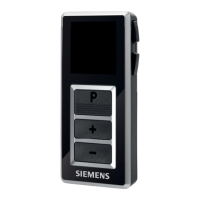
Do you have a question about the Siemens easyPocket and is the answer not in the manual?
| Brand | Siemens |
|---|---|
| Model | easyPocket |
| Category | Remote Control |
| Language | English |
Identifies and describes the main components and buttons of the easyPocket remote control.
Explains the icons shown on the display of an unprogrammed easyPocket remote control.
Details the display icons and power save mode for a programmed easyPocket remote control.
Details the default and optional functions assigned to the control buttons on the remote.
Explains the key lock switch function and the programming connection port.
Provides step-by-step instructions for inserting AAA batteries into the remote control.
Explains how to check the remote control's battery status via the menu or display.
Instructions for adjusting volume and switching hearing programs using the remote control.
Explains the process of turning hearing instruments on and off using the remote control.
Details how to adjust the tinnitus noiser level if configured by a Hearing Care Professional.
Step-by-step guide for setting a daily alarm reminder on the easyPocket remote control.
Instructions on how to stop the alarm when it rings and how to disable the function.
Guide to setting the current time and date on the easyPocket remote control.
Instructions on how to restore default volume, programs, or factory settings.
Procedure to view contact data and understand the service notifier function.
Steps for pairing hearing instruments with the easyPocket, primarily for professionals.
Provides guidelines on how to safely clean and care for the easyPocket remote control.
Addresses common problems like the remote not working or interference issues.
Defines the proper application of the remote control and clarifies the meaning of symbols.
Specifies conditions for transport, storage, and proper disposal of the device and batteries.
Lists technical specifications and details FCC, IC, and European directive compliance.
Highlights hazards like choking, injury, and unauthorized modifications to the device.
Warns about lanyard entanglement, electronic interference, and use in specific environments.
Covers risks related to active implants, explosive atmospheres, and radiofrequency exposure.
Advises on protecting the device from environmental factors and potential radiation damage.
Discusses compatibility and potential interference with telecoil programs and other devices.